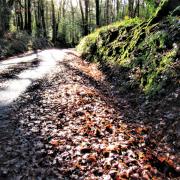Rugged Dartmoor is home to thousands of ‘letterboxes’ as Chrissy Harris discovers Photography by Steven Haywood

Following clues and finding treasure is a thrill some of us never grow out of. Just ask Roger Paul. The grandfather has spent the past 33 years on a tireless quest to collect as many of the thousands of ‘letterboxes’ or stamps hidden across Dartmoor as is humanly possible.

And he’s not doing too badly. So far Roger and his wife Stephanie have gathered – wait for it – around 50,000 stamps and they’re not done yet.
Letterboxing is a pastime enjoyed by generations and involves following clues (such as a map reference or compass bearing) to discover a small pot containing a stamp and visitors’ book.
These pots, or letterboxes, are hidden all over Dartmoor, particularly on and around its tors.
When a pot - usually a weather proof box - is found, the letterboxer takes a copy of the stamp and leaves their own print in the visitors’ book.
The practice began on Dartmoor during Victorian times and still delights Devon locals and visitors alike, who scale rocks and hike for miles in pouring rain just to get their ‘reward’.
“There’s no doubt about it,” says Roger Paul, who lives in Throwleigh, near Okehampton. “It’s like a treasure hunt.
“For families it’s great because it puts them out on the moors and rather than just go for a simple walk, they have an objective.
“Often it takes you that bit further and to places you wouldn’t normally go to on Dartmoor. It’s a great way to explore.”
There can be up to 5,000 letterboxes dotted across Dartmoor at any given time.
Anyone can set up a stamp set and many are created by charities, individuals and other organisations, keen to be to be a part of this outdoor pursuit that has spread to areas all over the world.
Roger Paul has fuelled his passion by helping to run the Letterbox 100 club, an organisation that rewards hikers for collecting one hundred stamps.
There are certificates and badges for 100, 500 and even up to 5,000 stamps.
The group publishes a catalogue of Dartmoor letterboxes twice a year and arranges ‘meets’ to offer information to walkers of all ages.
“It’s a great way for people to get started,” says Roger. “We get all sorts coming along of all ages and from all over the world. Letterboxing on Dartmoor is really popular with the Germans, the Austrians and the Dutch. We’ve also taken film crews out who’ve been down here working on programmes.”
Roger says the best way to get started is to come to a meet or to do a charity walk.
Many charities raise funds by putting out a trail of stamps and selling the clues.
Harly Catchpole, nine, has gathered a few letterboxes in his time.
The schoolboy from Newton Abbot has 500 in his collection and is working his way up towards the coveted 1,000 certificate.
“I just really like it,” he says. “I go around looking everywhere, under rocks. It’s good because it means you get to go on lots of different tors and that’s fun.
I’m hoping I’ll be able to get them all one day but I know that will be hard.”
Harley’s dad Bryan says his son is determined once he gets started and the family have often been out until dusk on their letterbox missions.
“It will be getting dark but Harley will tell us that we can’t leave the moor until he’s found at least another four,” says Bryan.
“It’s something we like doing as family and it gets you out in the fresh air. What could be better?”
Mike Nendick, communications officer from Dartmoor National Park Authority, says letterboxing is a great way to explore the area’s beautiful and rugged landscape.
“Anyone can do it – as long as you’ve got the ability to navigate a bit and use a map and a compass, you can just get going.
“It gives people a purpose to their walk and, let’s face it, it’s like a treasure hunt.”
Mike says many people have set up their own stamps over the years and the letterboxing landscape is always changing.
“There are a few rules in place to make sure it’s safe – for instance people need to be careful not to place them in areas the military use or sites of archaeological interest,” he says.
“But they can be in all sorts of places. Some are easier to get to than others.It’s all part of the challenge.”
But is the reward just as sweet when you’re on your 50,000th letterbox?
“Oh I still get excited when I find a new one,” says Roger. “I’ll carry on for as long as I’m able. We’ll never get them all but that’s what keeps you going.”
Don’t miss next month’s issue of Devon Life when we’ll be revealing details of our own special letterbox stamp hidden on Dartmoor – and how you could win a year’s subscription if you’re the first to find it.
To find out more about letterboxing on Dartmoor, visit letterboxingondartmoor.co.uk or dartmoor-npa.gov.uk.
The next Dartmoor Letterboxing meet will be held at 10am on March 30 at Lee Moor village hall.
The history of letterboxing:
Letterboxing began in 1854 when a Dartmoor guide called James Perrott placed a glass bottle at Cranmere Pool on north Dartmoor.
He encouraged hikers who tackled the tricky walk to the bleak site to leave their calling card in the bottle as a record of their achievement.
From this hikers began to leave a letter or postcard inside a box along the trail, sometimes addressed to themselves, a friend or relative, hence the name ‘letterboxing’.
The next person to discover the site would collect the postcards and send them.
Clues were circulated for other ‘letterboxes’ that had been hidden on the moor and a map was produced.
Further letterboxes were established at Taw Marsh (1894), Ducks Pool (1938) and Crow Tor (1962).
Nowadays, a rubber stamp and visitors’ book are hidden in a small container and a clue to its position is shared by word of mouth or through the 100-Club.
In the past, stamps were hidden in army ammunition tins, but today they are concealed in ‘pill-pots’ or plastic containers.
A set of rules has been established to avoid damage to the moor.
This article was first published in the March issue of Devon Life. To get the magazine delivered every month to your home, subscribe at www.subscriptionsave.co.uk/dev or call 08448484217



























